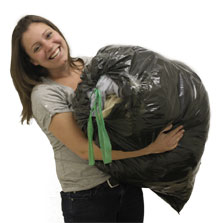Why Should I Recycle Used Clothing?
Clothing and household textiles currently make-up 4.67% of the waste stream.
The used clothing industry provides lower income people around the world with affordable clothing. Clothing that is damaged is recycled into wiping rags. Clothing and textiles notsuitable for wiping purposes are processed back into fibers that are then remanufactured into paper, yarn, insulation, carpet padding, sound proofing, etc.
Recycling vs. manufacturing has many "green" benefits, including:
- Carbon Footprint Reduction
- Clean Air Preservation
- Reduced Energy Consumption
- Water Conservation
- Woodland Conservation
Recycling textiles protects the environment from exposure to tons of harsh chemicals, waste products and waste water used in the manufacturing vs. recycling process of clothing.
How We Recycle
Reduce. Reuse. Recycle.
We Reduce solid waste through the life extension of textiles while also reducing energy & water consumption through the distribution of reclaimed wipers (recycled rags) vs. manufactured. The use of reclaimed wipers support a cleaner, healthier environment.
We Reuse gently worn clothing through wholesaling or exporting to less than developed or developing countries (secondhand clothing as well as household an industrial linens).
We Recycle old garments, towels and institutional linens as they are transformed to wiping cloths needed for industrial use.
What Happens to My Clothing?
45% of donated items are worn as second hand clothing.
30% of donated items are recycled into wiping cloths.
15% of donated items are reprocessed into fibers.
5%* of donated items are unusable.
*This number is shrinking, as more processing facilities become zero waste!

